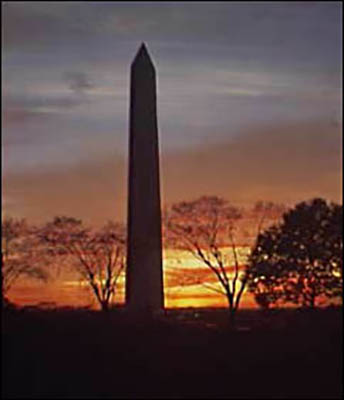Last updated: August 24, 2021
Lesson Plan
The Washington Monument: Tribute in Stone

- Grade Level:
- Middle School: Sixth Grade through Eighth Grade
- Subject:
- Literacy and Language Arts,Social Studies
- Lesson Duration:
- 90 Minutes
- Common Core Standards:
- 6-8.RH.2, 6-8.RH.3, 6-8.RH.4, 6-8.RH.5, 6-8.RH.6, 6-8.RH.7, 6-8.RH.8, 6-8.RH.9, 6-8.RH.10, 9-10.RH.1, 9-10.RH.2, 9-10.RH.3, 9-10.RH.4, 9-10.RH.5, 9-10.RH.6, 9-10.RH.7, 9-10.RH.8, 9-10.RH.9, 9-10.RH.10
- Additional Standards:
- US History Era 6 Standard 2C: The student understands how new cultural movements at different social levels affected American life.
Curriculum Standards for Social Studies from the National Council for the Social Studies. - Thinking Skills:
- Remembering: Recalling or recognizing information ideas, and principles. Understanding: Understand the main idea of material heard, viewed, or read. Interpret or summarize the ideas in own words. Applying: Apply an abstract idea in a concrete situation to solve a problem or relate it to a prior experience. Analyzing: Break down a concept or idea into parts and show the relationships among the parts. Creating: Bring together parts (elements, compounds) of knowledge to form a whole and build relationships for NEW situations. Evaluating: Make informed judgements about the value of ideas or materials. Use standards and criteria to support opinions and views.
Essential Question
Who do Americans choose to memorialize and how?
Objective
1. To understand some of the reasons Washington was so revered during the early 19th century;
2. To describe the intentions behind the memorial to George Washington;
3. To analyze how ideas about the best designs for a monument change over time;
4. To investigate memorials found in their community.
Background
Time Period: 1760s-1880s
Topics: This lesson could be used in teaching units on the American Revolution and the early Federal period as the focus for a discussion of whether Washington deserved the reverence he inspired. It could be part of units on the formation of national identity, collective memory, and interpretations of the past. It could also be used in units on art history, architecture, or urban planning.
Preparation
It rises tall and brilliant, its whiteness emphasized by the green grass and colorful flags that surround it. It stands at the heart of Washington, D.C., near the center of a cross formed by four of America's most famous buildings: the U.S. Capitol and the Lincoln Memorial, the White House and the Jefferson Memorial.
But appearance and location are not the only reasons that the Washington Monument is one of the country's most recognizable structures. Its prominence comes also because it commemorates George Washington, who remains one of the country's most admired leaders more than two centuries after his death. The history of the monument reflects his contributions to the development of the United States and shows how Americans have debated the best way to honor important citizens.
Lesson Hook/Preview
George Washington (1732-1799) became involved in military and political affairs long before most American colonists considered breaking away from Britain. In 1754, for example, Virginia's governor sent the 21-year-old Washington to the Ohio Valley to warn the French to stay out of lands claimed by Great Britain; the ensuing French and Indian War provided him valuable military experience. In subsequent years he gained election to Virginia's colonial assembly and became a justice in his county's court system.
In 1774 Washington was one of Virginia's representatives to the First Continental Congress in Philadelphia. The following year delegates to the Second Continental Congress chose him to lead the newly-created Continental Army. Twenty years had passed since he had commanded troops, but he was a man of upright character, favored moderate politics, and could be counted on to secure Virginia's support for a fight whose main advocates were concentrated in New England. Washington led this army to victory over the British, then retired to his plantation. He reentered public life in 1787, when he agreed to preside over the convention called to find solutions to the problems that existed under the Articles of Confederation. The Constitution that emerged from that summer in Philadelphia established the office of President, and Washington was the obvious choice to fill the position.
Procedure
Getting Started Prompt
Map: Orients the students and encourages them to think about how place affects culture and society
Readings: Primary and secondary source readings provide content and spark critical analysis.
Visual Evidence: Students critique and analyze visual evidence to tackle questions and support their own theories about the subject.
Optional post-lesson activities: If time allows, these will deepen your students' engagement with the topics and themes introduced in the lesson, and to help them develop essential skills.
Vocabulary
monument
commemoration
Articles of Confederation
First Continental Congress
Second Continental Congress
Additional Resources
The Washington Monument
The Washington Monument is a unit of the National Park System. The park's web page describe more of the monument's history, from its construction to its recent renovation.
The National Park Service
The Washington Monument is just one of the units of the national parks that considers Washington's life. The NPS's Historical Themes in America Web page offers links to related National Park Service sites. Particularly informative are Government: Presidents and Military History: Revolutionary War.
Washington, DC, Travel Itinerary
The National Park Service's online travel itinerary, "Discovering Women's History in Washington, DC," provides information where women’s history is highlighted in the city, on and off the National Mall.
American Presidents Travel Itinerary
The Discover Our Shared Heritage online travel itinerary on American Presidents provides information on places associated with the 1st President of the United States, George Washington, including the Washington Monument, and Mount Vernon.
Library of Congress
The Library of Congress's digital collections has a wide variety of resources on George Washington including documents, photographs, and other material on his life.
The George Washington Masonic National Memorial
Compare other types of private and public memorials to George Washington. The George Washington Masonic National Memorial, for example, is in Alexandria, Virginia, just south of Washington, D.C.
